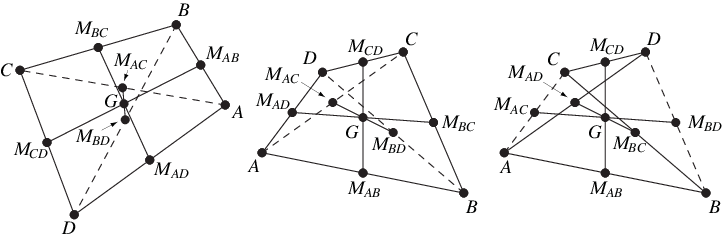The centroid is center of mass of a two-dimensional planar lamina or a three-dimensional solid. The mass of a lamina with
surface density function is
|
(1)
|
and the coordinates of the centroid (also called the center of gravity) are
|
(2)
| |||
|
(3)
|
The centroid of a lamina is the point on which it would balance when placed on a needle. The centroid of a solid is the point on which the solid would "balance."
The geometric centroid of a region can be computed in the Wolfram Language using RegionCentroid[reg].
The centroid of a set of point masses
located at positions
is
|
(4)
|
which, if all masses are equal, simplifies to
|
(5)
|
For a closed lamina of uniform density with boundary specified by for
and the lamina on the left as the curve is traversed,
Green's theorem can be used to compute the centroid
as
|
(6)
| |||
|
(7)
|
The positions of the geometric centroid of a planar non-self-intersecting polygon with vertices , ...,
are
 |
(8)
| ||
 |
(9)
|
where
is the polygon area and
and
(Bourke 1988, Nürnberg 2013).

The centroid of the vertices of a quadrilateral occurs at the point of intersection of the bimedians (i.e., the lines and
joining pairs of opposite midpoints)
(Honsberger 1995, pp. 36-37). In addition, it is the midpoint
of the line
connecting the midpoints of the diagonals
and
(Honsberger 1995, pp. 39-40).
Given an arbitrary hexagon, connecting the centroids of each consecutive three sides gives the so-called centroid hexagon, a hexagon with equal and parallel sides (Wells 1991).
The centroid of a semicircle of radius is given by
|
(10)
|
The centroids of several common laminas bounded by the following curves along the nonsymmetrical axis are summarized in the following table.
In three dimensions, the mass of a solid with density function is
|
(11)
|
and the coordinates of the center of mass are
|
(12)
| |||
|
(13)
| |||
|
(14)
|